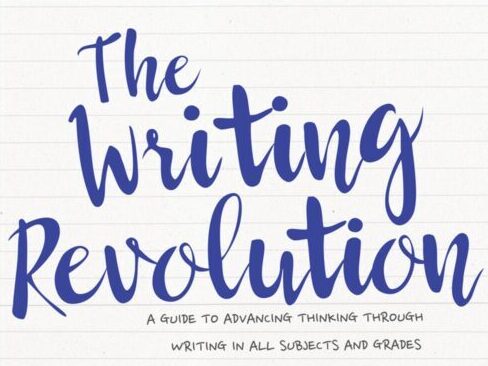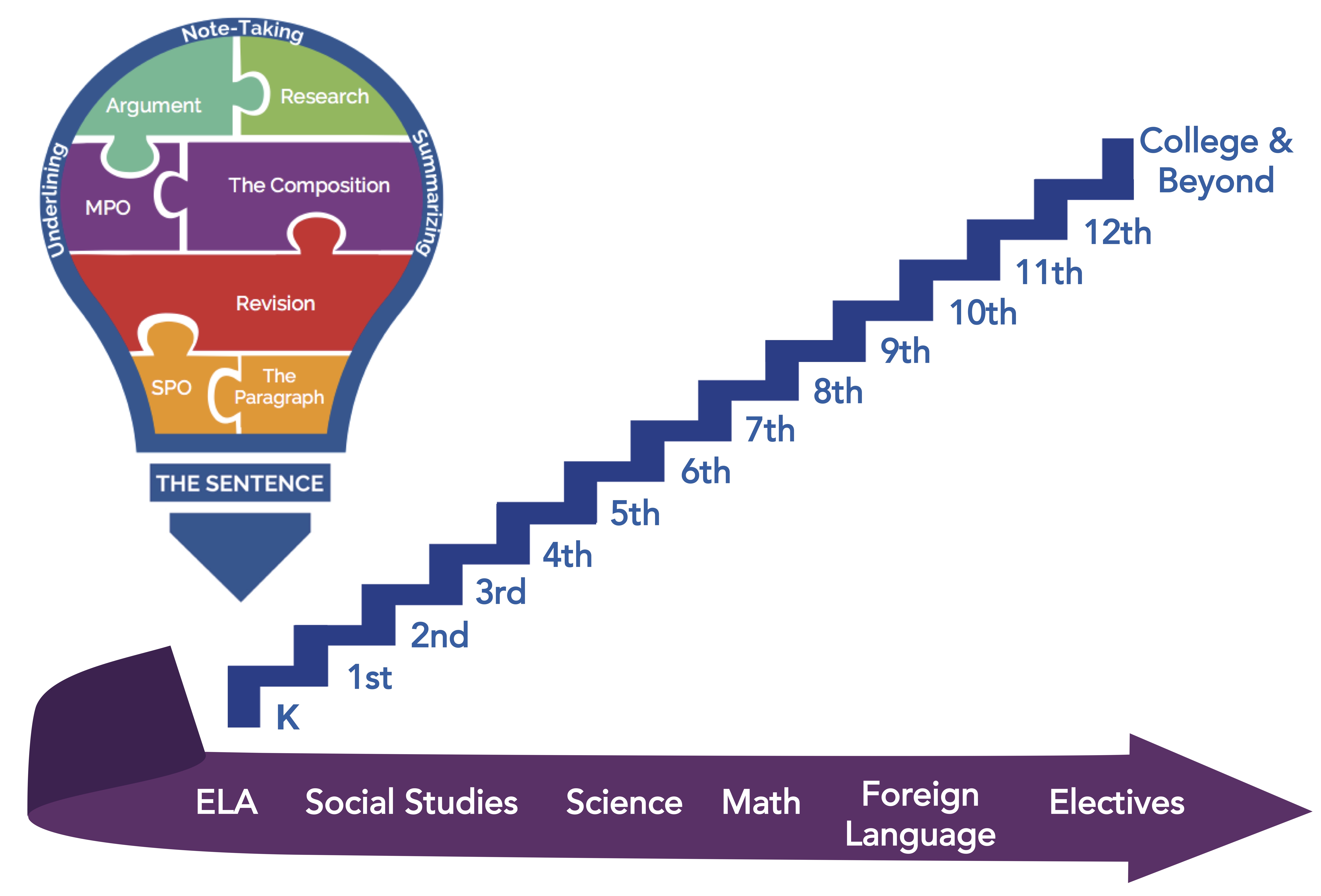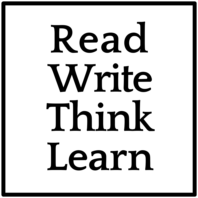
Last time on RWTL…
In my last post, I introduced self-regulated strategy development (SRSD) as a way to teach writing that’s supported by more than 100 experimental and quasi-experimental studies. A key part of SRSD is teaching children to write and combine grammatically accurate sentences with increasing fluency. Achieving this in the early years of primary school frees up cognitive resources for them to focus on the many higher-order writing skills, mnemonics, and strategies (cognitive, genre, and self-regulation) taught as part of SRSD throughout the school years (Graham et al., 2018). I described this approach to grammar (and writing more widely) as sociocognitive, in that it gives attention to both the cognitive and social elements of writing. The emphasis on grammar in SRSD is important but limited.
Another way to teach writing that has become quite popular lately in Australian schools is Judith Hochman and Natalie Wexler’s (2017) The Writing Revolution (TWR). TWR treats grammar quite similarly to SRSD, in that it recommends teaching a select set of grammatical features explicitly to help children write and combine sentences. There are also some key differences to keep in mind. Before we explore the set of grammatical features taught explicitly in TWR, let’s first look at some key ideas of this approach.
NOTE: Because I couldn’t locate any research that has investigated the effectiveness of TWR, I’ve had to draw directly on the TWR book for the information in this post, as well as the notes I took as I completed a short course in TWR in early 2021. If you value evidence-based practices, it might pay to wait until TWR is evaluated by a decent number of independent empirical studies before using it as your main approach to teaching writing.
What is The Writing Revolution?
Hochman and Wexler describe TWR as a method of teaching content as much as it is a method of teaching writing. They suggest teachers should not have a separate writing block or writing curriculum, but should instead weave the TWR strategies into their existing curriculum and instruction. In the authors’ words, “The Writing revolution aims to break the writing process down into manageable chunks and have students practice those chunks repeatedly, while also learning content” (p. 7). Right away then, this hints at TWR being designed in a slightly different way to other approaches.
The book’s content can be split into three main stages or parts: sentence-level writing, single paragraph writing, and multiple paragraph writing and full compositions. If there’s interest, I’d be happy to unpack the intricacies of each stage of TWR, but in this introductory post, I’ll focus on its approach to sentence-level writing since this is where it includes explicit grammar teaching.

(Image ref: The Hochman Method | The Writing Revolution)
Sentence-level writing in TWR
TWR gives teachers several activities to guide students to write complete sentences, vary their structure, and use complex vocabulary in content area teaching. This comes before other supports for longer forms of writing. Importantly, what students write sentences about and how they write them is determined by the content area, rather than from any notion of genre or text type. This sets TWR apart from SRSD or genre-based pedagogy, which we’ll explore in the next post.
Because of its exclusive focus on sentence-level writing in the first stage of the method, there is a risk that teachers and students may spend longer than necessary (i.e., several years of primary school) going over the same limited set of strategies. For this reason, I’d suggest being mindful of the actual end goal of TWR: assisting students to write a variety of longer-form written genres to suit a variety of social purposes. While the sentence-level strategies are useful to teach and return to recursively over time, don’t stop at sentences, especially in upper primary and secondary school contexts, or you’ll be missing the best of what TWR has to offer.
TWR and the teaching of grammar
Hochman and Wexler (2017) argued that “grammar is best taught in the context of student writing” (p. 8). Proponents of genre-based pedagogy (like Beverly Derewianka, David Rose, Sally Humphrey, and many others) would make the same claim. But the way TWR suggests teaching grammar in context is very different to the genre-based pedagogy approach.
While I can see several obvious grammatical features that are explicitly taught in TWR, Hochman and Wexler stress a number of times that teachers shouldn’t teach developing writers a rich metalanguage (in other words, a language for talking and reasoning about language choices). Instead, they argue that teaching children to combine simple sentences into complex sentences is enough to teach what they consider to be the important parts of grammar. This approach “eliminates the need to devote mental energy to memorizing and remembering grammatical terms” (p. 15). This would include things like nouns, verbs, adjectives, and prepositions on the traditional grammar side, or processes, participants, and circumstances on the functional grammar side.
This is a controversial idea, especially in Australia where these grammatical terms are explicitly mentioned in the content descriptions of the Australian Curriculum: English.
TWR’s love hate relationship with grammar
Hochman and Wexler suggest that rather than using technical grammatical terms that may confuse students, teachers should simply give examples of sentences that use these words. But in many places throughout the book, TWR doesn’t ignore all grammatical terms; it includes a range of sentence writing activities that require teachers and students to know the names and uses of quite a few grammatical features. With this in mind, let’s look at a summary of all the sentence-level writing strategies included in TWR and we’ll spot some grammatical features along the way.

Comparing the emphasis on grammar in SRSD and TWR
As I hope this post makes clear, TWR’s take on grammar is similar in some ways to that of SRSD: teach a select range of grammatical features explicitly to strengthen sentence-level writing. Where I think they differ is in explicitness and sequencing.
1. Explicitness about grammatical features
The authors of TWR make it crystal clear which grammatical features they believe matter for writing, what they look like in writing, and the order in which they should be taught. They have produced various classroom resources highlighting these features for both teachers and students, and dedicate many pages of their book to outlining what the teaching of sentence-level writing should look like in practice. Assuming these are actually the grammatical features that matter, it wouldn’t take any primary school teacher long to start teaching grammar for sentence-level writing with TWR.
By contrast, it was less simple to identify foundational grammatical features in the SRSD literature, possibly because grammar is not as strongly foregrounded in SRSD teaching (which has many other things going on). Several times I came across broad suggestions in SRSD papers and reports to teach the text features and syntactical combinations of different genres, and to help students emulate the features of effective writing, but what these features and syntactical combinations are was usually not discussed. This is not to say that SRSD doesn’t have any focus on grammar teaching (see my last post for more on where grammar plays an important role); it’s just not as explicit about grammar as TWR.
2. Sequence of teaching
One of the most unique (and controversial) ideas about TWR is the claim that teachers should only teach children to write sentences when they’re initially learning to write. While the authors do suggest the need for flexibility and teacher judgement in terms of when to move from one stage of TWR to the next, the book broadly suggests that sentence-level writing should be the main focus of writing instruction for students in the early and middle primary years, or up to around Year 4. I haven’t come across any research to suggest students should start with sentences rather than smaller building blocks like grammar or larger genre structures, but Hochman and Wexler (2017) offer the following seemingly reasonable justification for this:
A writer who can’t compose a decent sentence will never produce a decent essay-or even a decent paragraph. And if students are still struggling to write sentences, they have less brain power available to do the careful planning that writing a good paragraph or composition requires. (p. 10)
Hochman and Wexler suggest treating these sentence-level strategies recursively: “You’ll want to keep moving through your curricular sequence, bringing previous strategies into your instruction and using them alongside others as the content becomes more challenging” (p. 219).
Several of these sentence-level activities (e.g., appositives, sentence types, subordinating conjunctions) are drawn on for different effects in more advanced TWR tasks such as creating a multiple-paragraph outline for a full composition. For this reason, Hochman and Wexler argue that all students being introduced to TWR should initially learn the sentence-level strategies and proceed through the sequence in order. This means any teacher interested in using TWR’s strategies in classrooms will require knowledge of the grammatical features listed above.

The idea that you should only focus on sentence-level writing until this is mastered might work against the requirements of curriculum documents like the Australian Curriculum: English (and possibly the Common Core State Standards in the US), which require teachers to introduce students to the purposes and structures of a variety of written genres from the first year of primary school (i.e., Foundation).
A singular focus on sentence-level writing also doesn’t recognise that the choices students make when writing sentences are influenced by several factors (e.g., the genre they are writing, the purpose of writing, for whom they are writing, etc.). The risk here is that children who learn to write with TWR will be very strong at writing sentences in a certain way most suited to informative or factual texts, but may struggle more than the typical student when required to write sentences for other kinds of texts like narratives or procedures.
This is not to say that all children should be tasked with writing long compositions with multiple paragraphs from the very beginning of school, even before they can write a sentence! Rather, I’m suggesting that young children are quite capable of thinking and talking about different reasons for communicating and that people use language (oral, written, visual) for many purposes every day. This is how the Australian Curriculum: English is designed, and it seems to clash slightly with the singular focus on sentence-level writing in the first stage of TWR.
Next time on RWTL…
SRSD and TWR provide two approaches for teaching writing that involve explicitly teaching grammar for sentence-level writing. Next time, we’ll explore genre-based pedagogy, which involves teaching grammar as choice. Grammar plays an important but relatively limited role in SRSD and TWR, a bit like an entree to start a three-course meal. By contrast, grammar is the main course of genre-based pedagogy, as we’ll see next time. Yum yum.
Have you come across TWR before? Perhaps you’ve even had a go at teaching writing with some of the TWR strategies. If so, it would be great to hear how that experience has been for you and your students. Or, perhaps you’d like to learn more about TWR. Personally, I can’t wait for some empirical studies to come out that show the effectiveness of TWR, especially since SRSD is so well-supported by research. Let’s have a conversation about it on Twitter.
If you’d like to purchase the TWR book, and you are in Australia, here’s a link to Booko where you can find the cheapest electronic and printed copies.
References
Hochman, J. C., & Wexler, N. (2017). The writing revolution: A guide to advancing thinking through writing in all subjects and grades. Jossey-Bass.
Graham, S., Bollinger, A., Booth Olson, C., D’Aoust, C., MacArthur, C., McCutchen, D., & Olinghouse, N. (2018). Teaching elementary school students to be effective writers: A practice guide Teaching elementary school students to be effective writers. National Center for Education Evaluation and Regional Assistance, Institute of Education Sciences, U.S. Department of Education. http://ies.ed.gov/ncee/wwc/publications_reviews.aspx#pubsearch

My senior History students who struggle with writing have lapped up TWR sentence level strategies. The recognition that a complex sentence can place heavy cognitive demands on students is also something that has reshaped my approach to writing instruction. I also welcome the emphasis that TWR places on subject knowledge. I’ve felt for a long time that poor essay writing in History, while related to poor grammar and text-level organisation, is just as much a product of having nothing to actually say. Once students have thought about what they know, the demands of the question, what they want to say, and with what related content, the focus can then shift to crafting of sentences that work together within a paragraph, and paragraphs that support and overarching thesis. Argument is of course big in History. However, I wonder if our educational disdain for narrative (it’s not what the ‘markers’ want) has undermined the most basic way in which historical knowledge is organised: chronological understanding. We then ask for sophisticated judgements and are surprised when students can’t appreciate, for example, that the Nazis had to compete for votes long before the Nuremberg rallies (with which they are more familiar). This small piece of knowledge has the power of helping form a more complex argument. Without it, students tend to offer generic judgement claims (not arguments) that simply turn the question into a statement. As I often say to my seniors, I can teach a year 3 student to do that.
Hi David,
Thanks for your considered comment. It’s wonderful to hear your senior History students have taken to the TWR sentence-level strategies. This is what matters at the end of the day: does the approach actually work with students in classrooms. I also feel the emphasis on subject knowledge in TWR is very helpful. My other favourite element (which I’ll have to write about in a future post) is the TWR approach to abbreviated note-taking, which makes it easier for students to jot down ideas in writing quickly without worrying about writing in full sentences or with perfect spelling. While there aren’t any empirical studies about TWR’s effectiveness yet, there is quite a bit of anecdotal evidence that teachers and students like the approach in a variety of settings. It is important to look at whether this improves their writing too, but certainly how a student feels about the writing process has a direct impact on their writing outcomes (as shown in research by Steve Graham and others).
Thanks too for your comments about argumentation in history. While I’m a humble literacy lecturer, I try to read widely and came across a great paper this morning by Mierwald and colleagues in the European Journal of Psychology of Education that might be of interest to you (see here: https://link.springer.com/article/10.1007%2Fs10212-021-00541-5). They conducted a quasi-experimental study that looked at the impact of source authenticity on the quality of argumentative writing in history classrooms. They found that students who worked with authentic primary sources wrote considerably stronger arguments than students in groups that had less authentic sources and a history textbook. This supports your point that writing is extremely complex and while a given approach might teach the features of a sentence or genre, the student needs sufficient subject knowledge and be able to work with existing texts in nuanced ways to discover and articulate their own positions about often controversial ideas.
I could go on here but I’ll leave it there. Thanks again for your engagement in the post and I’m really pleased to hear TWR has been working well for you and your students.
I have been doing some research into TWR for my PGCE and came across this evaluation report: https://www.guidestar.org/ViewEdoc.aspx?eDocId=1956692. It’s not peer-reviewed research but offers some useful data on the impact of TWR on writing outcomes.
This is great! Thanks, Rebecca. I’ll share it on Twitter too since I know a few people who are keen to see what kind of difference TWR makes. The results look promising.
Take care,
Damon